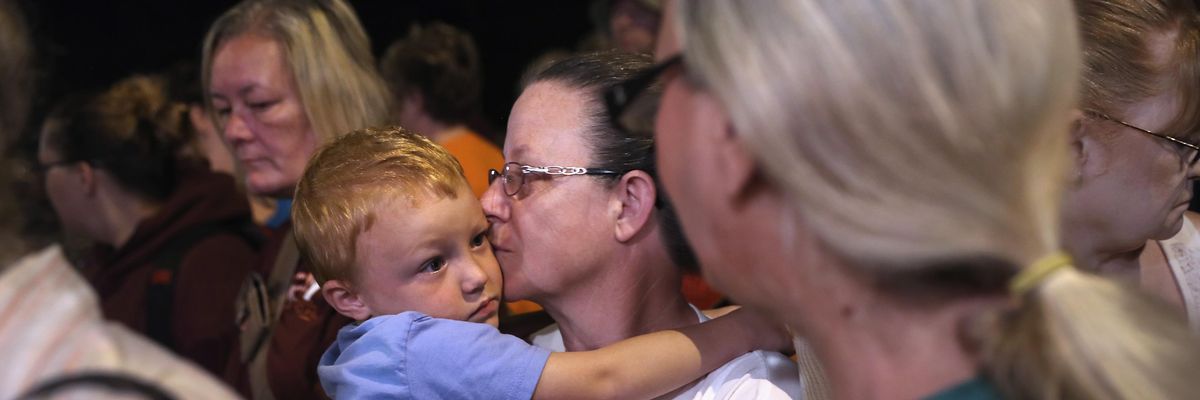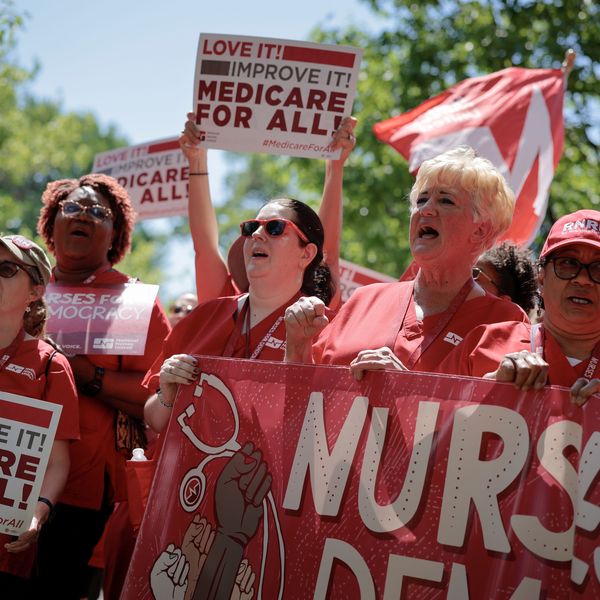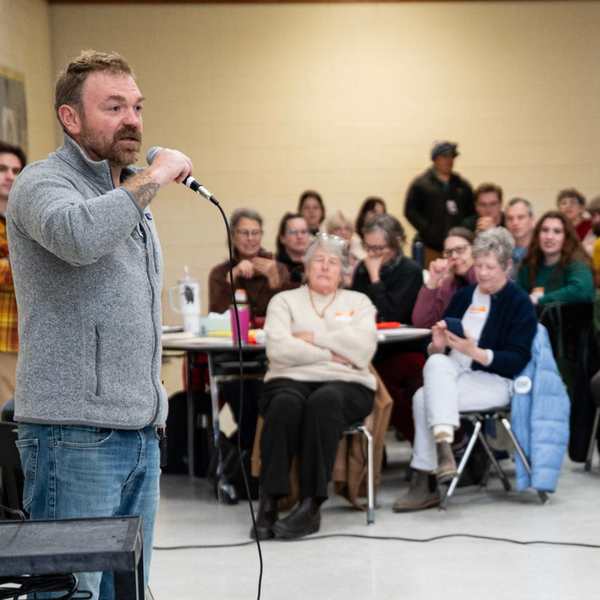
Ruby Partin, 63, and her adoptive son Timothy Huff, 5, wait for a free clinic to open in the early morning of July 22, 2017 in Wise, Virginia. Hundreds of Appalachia residents waited through the night for the annual Remote Area Medical (RAM), clinic for dental, vision and medical services held at the Wise County Fairgrounds in western Virginia. The county is one of the poorest in the state, with high number of unemployed and underinsured residents. (Photo: John Moore/Getty Images)
It's Time for the Adults in This Nation To Talk Seriously About Medicare for All
Today, we breathe a quick sigh a relief. But we cannot celebrate a return to the failed status quo.
Hundreds of people slept overnight in cars, or camped for days in a field. They told stories of yanking out their own teeth with pliers, of reusing insulin syringes until they broke in their arm, of chronic pain so debilitating they could hardly care for their own children. At daybreak, they lined up for several more hours outside a white tent, waiting for their chance to visit a doctor. For many, this was the first health care provider they've seen in years.
Is this a place torn by war, famine or natural disaster? No, this charity medical clinic was last weekend in southwest Virginia, in the wealthiest country in the world, where we spend nearly three times as much money on health care as other similar countries.
"It's as if our system was designed to deny care."
And what do we get for our money? The very definition of health care rationing: 28 million Americans without insurance, and millions more insured, but avoiding treatment because of sky-high deductibles and co-pays. Compared to ten other wealthy countries, the U.S. ranks dead last for life expectancy, and access to care. We even have the lowest number of hospital beds per capita, a way that health experts measure the capacity of a nation's health system. It's as if our system was designed to deny care.
America does hit the top of the list in some areas. Compared to other nations, American doctors and patients waste the most hours on billing and insurance claims. We have the highest rate of infant mortality, and the highest percentage of avoidable deaths--patients who die from complications or conditions that could have been avoided with timely care.
Clearly, this system is broken. Like a cracked pipe, money gushes into our health care system but steadily leaks out. Money is siphoned into the advertising budgets of insurance companies and the army of corporate bureaucrats working to deny claims. Even more dollars are soaked up by the pockets of insurance CEOs who have collectively earned $9.8 billion since the Affordable Care Act was passed in 2010. Nearly a third of our health care dollars go to something other than health care.
President Trump recognized voters' frustration and campaigned on a promise of more coverage, better benefits, and lower costs. We couldn't agree more with these goals. However, instead of trying to fix our broken system, GOP leaders are acting more like toddlers, mid-tantrum, smashing our health system into smaller and smaller pieces, threatening to push even more Americans--the most vulnerable among us--through the cracks. Last night, a few Senate Republicans stood up and acted like adults, putting an end to this dangerous game.
Today, we breathe a quick sigh of relief. But we cannot celebrate a return to the status quo, a system that rations health care based on income and allows 18,000 Americans to die each year unnecessarily.
Where do we go from here?
Republicans had eight years to come up with a plan that achieves more coverage, better benefits and lower costs. Have our elected leaders simply run out of ideas?
"The good news is that we already have a proven model for health financing that is popular among both patients and physicians."
The good news is that we already have a proven model for health financing that is popular among both patients and physicians. It provides medically-necessary care to the oldest and sickest Americans with a fraction of the overhead of private insurance. It's called Medicare, and I can tell you as a physician that it has worked pretty darn well for more than 50 years.
Not only do we have a model, we have a bill that would expand Medicare to cover everyone and improve it to include prescriptions, dental, vision, and long-term care. It's called H.R. 676, the Expanded and Improved Medicare for All Act, a single-payer plan that would provide comprehensive care to everyone living in the U.S. The bill would yield about $500 billion annually in administrative savings while covering the 28 million currently uninsured. Medicare for all is gaining steam with a record 115 co-sponsors, a majority of House Democrats.
Now that Republican senators have finally worn themselves out, Sen. Bernie Sanders plans to file his own single-payer Medicare for all bill. Senators from both parties will be asked to choose a side: Do you support the current system of health care rationing, medical bankruptcies and unnecessary deaths; or a program proven to work both here and in every other developed country?
A majority of Americans now believe that health care is a human right, and that it is our government's responsibility to achieve universal coverage. We've tried everything else except Medicare for all. What are we waiting for?
An Urgent Message From Our Co-Founder
Dear Common Dreams reader, The U.S. is on a fast track to authoritarianism like nothing I've ever seen. Meanwhile, corporate news outlets are utterly capitulating to Trump, twisting their coverage to avoid drawing his ire while lining up to stuff cash in his pockets. That's why I believe that Common Dreams is doing the best and most consequential reporting that we've ever done. Our small but mighty team is a progressive reporting powerhouse, covering the news every day that the corporate media never will. Our mission has always been simple: To inform. To inspire. And to ignite change for the common good. Now here's the key piece that I want all our readers to understand: None of this would be possible without your financial support. That's not just some fundraising cliche. It's the absolute and literal truth. We don't accept corporate advertising and never will. We don't have a paywall because we don't think people should be blocked from critical news based on their ability to pay. Everything we do is funded by the donations of readers like you. Will you donate now to help power the nonprofit, independent reporting of Common Dreams? Thank you for being a vital member of our community. Together, we can keep independent journalism alive when it’s needed most. - Craig Brown, Co-founder |
Hundreds of people slept overnight in cars, or camped for days in a field. They told stories of yanking out their own teeth with pliers, of reusing insulin syringes until they broke in their arm, of chronic pain so debilitating they could hardly care for their own children. At daybreak, they lined up for several more hours outside a white tent, waiting for their chance to visit a doctor. For many, this was the first health care provider they've seen in years.
Is this a place torn by war, famine or natural disaster? No, this charity medical clinic was last weekend in southwest Virginia, in the wealthiest country in the world, where we spend nearly three times as much money on health care as other similar countries.
"It's as if our system was designed to deny care."
And what do we get for our money? The very definition of health care rationing: 28 million Americans without insurance, and millions more insured, but avoiding treatment because of sky-high deductibles and co-pays. Compared to ten other wealthy countries, the U.S. ranks dead last for life expectancy, and access to care. We even have the lowest number of hospital beds per capita, a way that health experts measure the capacity of a nation's health system. It's as if our system was designed to deny care.
America does hit the top of the list in some areas. Compared to other nations, American doctors and patients waste the most hours on billing and insurance claims. We have the highest rate of infant mortality, and the highest percentage of avoidable deaths--patients who die from complications or conditions that could have been avoided with timely care.
Clearly, this system is broken. Like a cracked pipe, money gushes into our health care system but steadily leaks out. Money is siphoned into the advertising budgets of insurance companies and the army of corporate bureaucrats working to deny claims. Even more dollars are soaked up by the pockets of insurance CEOs who have collectively earned $9.8 billion since the Affordable Care Act was passed in 2010. Nearly a third of our health care dollars go to something other than health care.
President Trump recognized voters' frustration and campaigned on a promise of more coverage, better benefits, and lower costs. We couldn't agree more with these goals. However, instead of trying to fix our broken system, GOP leaders are acting more like toddlers, mid-tantrum, smashing our health system into smaller and smaller pieces, threatening to push even more Americans--the most vulnerable among us--through the cracks. Last night, a few Senate Republicans stood up and acted like adults, putting an end to this dangerous game.
Today, we breathe a quick sigh of relief. But we cannot celebrate a return to the status quo, a system that rations health care based on income and allows 18,000 Americans to die each year unnecessarily.
Where do we go from here?
Republicans had eight years to come up with a plan that achieves more coverage, better benefits and lower costs. Have our elected leaders simply run out of ideas?
"The good news is that we already have a proven model for health financing that is popular among both patients and physicians."
The good news is that we already have a proven model for health financing that is popular among both patients and physicians. It provides medically-necessary care to the oldest and sickest Americans with a fraction of the overhead of private insurance. It's called Medicare, and I can tell you as a physician that it has worked pretty darn well for more than 50 years.
Not only do we have a model, we have a bill that would expand Medicare to cover everyone and improve it to include prescriptions, dental, vision, and long-term care. It's called H.R. 676, the Expanded and Improved Medicare for All Act, a single-payer plan that would provide comprehensive care to everyone living in the U.S. The bill would yield about $500 billion annually in administrative savings while covering the 28 million currently uninsured. Medicare for all is gaining steam with a record 115 co-sponsors, a majority of House Democrats.
Now that Republican senators have finally worn themselves out, Sen. Bernie Sanders plans to file his own single-payer Medicare for all bill. Senators from both parties will be asked to choose a side: Do you support the current system of health care rationing, medical bankruptcies and unnecessary deaths; or a program proven to work both here and in every other developed country?
A majority of Americans now believe that health care is a human right, and that it is our government's responsibility to achieve universal coverage. We've tried everything else except Medicare for all. What are we waiting for?
Hundreds of people slept overnight in cars, or camped for days in a field. They told stories of yanking out their own teeth with pliers, of reusing insulin syringes until they broke in their arm, of chronic pain so debilitating they could hardly care for their own children. At daybreak, they lined up for several more hours outside a white tent, waiting for their chance to visit a doctor. For many, this was the first health care provider they've seen in years.
Is this a place torn by war, famine or natural disaster? No, this charity medical clinic was last weekend in southwest Virginia, in the wealthiest country in the world, where we spend nearly three times as much money on health care as other similar countries.
"It's as if our system was designed to deny care."
And what do we get for our money? The very definition of health care rationing: 28 million Americans without insurance, and millions more insured, but avoiding treatment because of sky-high deductibles and co-pays. Compared to ten other wealthy countries, the U.S. ranks dead last for life expectancy, and access to care. We even have the lowest number of hospital beds per capita, a way that health experts measure the capacity of a nation's health system. It's as if our system was designed to deny care.
America does hit the top of the list in some areas. Compared to other nations, American doctors and patients waste the most hours on billing and insurance claims. We have the highest rate of infant mortality, and the highest percentage of avoidable deaths--patients who die from complications or conditions that could have been avoided with timely care.
Clearly, this system is broken. Like a cracked pipe, money gushes into our health care system but steadily leaks out. Money is siphoned into the advertising budgets of insurance companies and the army of corporate bureaucrats working to deny claims. Even more dollars are soaked up by the pockets of insurance CEOs who have collectively earned $9.8 billion since the Affordable Care Act was passed in 2010. Nearly a third of our health care dollars go to something other than health care.
President Trump recognized voters' frustration and campaigned on a promise of more coverage, better benefits, and lower costs. We couldn't agree more with these goals. However, instead of trying to fix our broken system, GOP leaders are acting more like toddlers, mid-tantrum, smashing our health system into smaller and smaller pieces, threatening to push even more Americans--the most vulnerable among us--through the cracks. Last night, a few Senate Republicans stood up and acted like adults, putting an end to this dangerous game.
Today, we breathe a quick sigh of relief. But we cannot celebrate a return to the status quo, a system that rations health care based on income and allows 18,000 Americans to die each year unnecessarily.
Where do we go from here?
Republicans had eight years to come up with a plan that achieves more coverage, better benefits and lower costs. Have our elected leaders simply run out of ideas?
"The good news is that we already have a proven model for health financing that is popular among both patients and physicians."
The good news is that we already have a proven model for health financing that is popular among both patients and physicians. It provides medically-necessary care to the oldest and sickest Americans with a fraction of the overhead of private insurance. It's called Medicare, and I can tell you as a physician that it has worked pretty darn well for more than 50 years.
Not only do we have a model, we have a bill that would expand Medicare to cover everyone and improve it to include prescriptions, dental, vision, and long-term care. It's called H.R. 676, the Expanded and Improved Medicare for All Act, a single-payer plan that would provide comprehensive care to everyone living in the U.S. The bill would yield about $500 billion annually in administrative savings while covering the 28 million currently uninsured. Medicare for all is gaining steam with a record 115 co-sponsors, a majority of House Democrats.
Now that Republican senators have finally worn themselves out, Sen. Bernie Sanders plans to file his own single-payer Medicare for all bill. Senators from both parties will be asked to choose a side: Do you support the current system of health care rationing, medical bankruptcies and unnecessary deaths; or a program proven to work both here and in every other developed country?
A majority of Americans now believe that health care is a human right, and that it is our government's responsibility to achieve universal coverage. We've tried everything else except Medicare for all. What are we waiting for?

